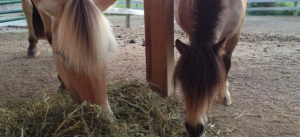 Feeding horses hay-based diets can be challenging but not impossible with these tips. Most horses not participating in heavy work can maintain a healthy body condition score. By being offered forage as the only source of calories. According to the National Research Council’s Nutrient Requirements of Horses. This being in addition to access to fresh water and a salt supplement.
Feeding horses hay-based diets can be challenging but not impossible with these tips. Most horses not participating in heavy work can maintain a healthy body condition score. By being offered forage as the only source of calories. According to the National Research Council’s Nutrient Requirements of Horses. This being in addition to access to fresh water and a salt supplement.
Tricks for managing horses without supplemental calorie sources:
- Weigh your horse’s hay based on your horse’s target body weight and ensure your horse is receiving 1.5–2.5% of its body weight in forage each day.
- Have a veterinarian or equine dentist routinely examine and treat your horse’s teeth. Don’t assume the horse has a functional mouth if you simply pull back his lips and find a full set of incisors. Aged horses lose front teeth last. The molars you don’t see grind forage. Additionally, if your horse is not able to chew its hay sufficiently, consider cut hay as an alternative.
- If the horse is overweight, restrict grazing and offer mature hay with a lower content of easily digestible sugars and higher indigestible fiber. However, be sure that the horse will actually eat it and not just use it for bedding.
- Feed off the ground to minimize the chance of sand colic in areas where this is a concern. Use nets, feed bunks, feed racks, or place the hay on rubber stall mats.
- Hay shortage in your area? Consider hay cubes, alfalfa (lucerne) or grass hay pellets, chopped forages, shredded beet pulp, or soy hull pellets.
- Invest in a few hay nets. This will elevate the hay off the floor, away from sand and bedding dust. Therefore making it easy to weigh and preload hay. Subsequently to quickly feed hungry horses on busy days, and potentially slow consumption.
- Soak or steam hay to reduce dust if your horse has a respiratory ailment or to reduce the water-soluble sugar content for horses with endocrine abnormalities or chronic laminitis.
In the case of harder keepers, Kathleen Crandell, Ph.D., nutritionist at Kentucky Equine Research, believes a forage-only diet can be challenging.
“Making sure the horse has the best-quality forage will go a long way to increasing the caloric intake. Abundant grass and legumes (like clover) in the pasture and high-quality alfalfa, grass, or mixed hay with a high leaf-to-stem ratio are excellent sources of forage calories. Supplementing with the forage alternatives, such as hay cubes and pellets or beet pulp, will further increase the calories the horse derives from the forages.”
Crandell also warns, “An all-forage diet does not work for every horse in every circumstance. There are definitely situations where a more robust diet may be indicated.”
Above all, while hay can often supply adequate calories, keep in mind that depending on the origin of the forage, additional minerals and vitamins may be necessary to balance out the deficiencies of the forage. An equine vitamin supplies this. In addition, mineral supplement or a ration balancer.
In conclusion, would you like help evaluating your horse’s diet? Contact us at J & J Farms by clicking here!
Article brought to you by KER.
